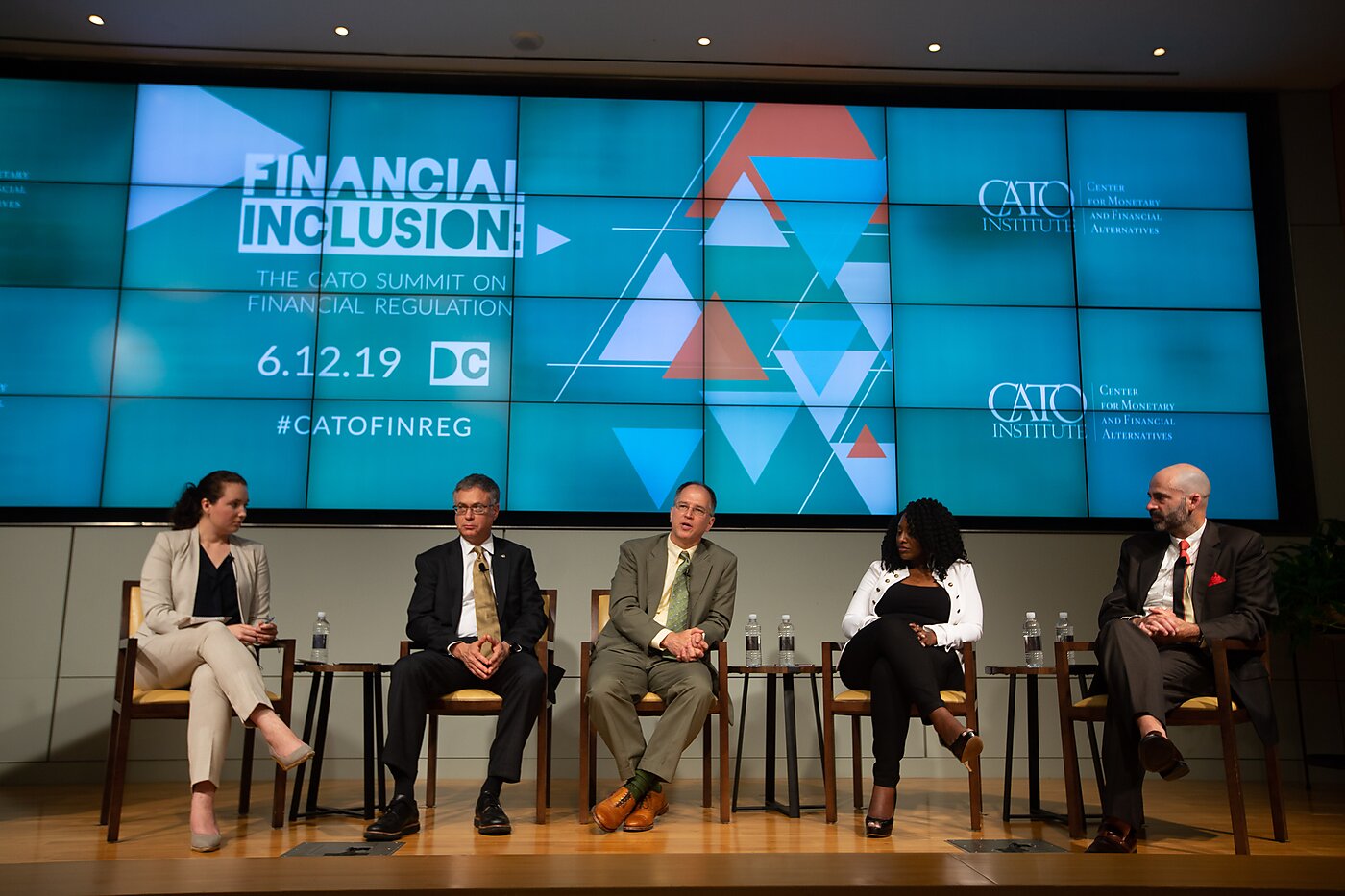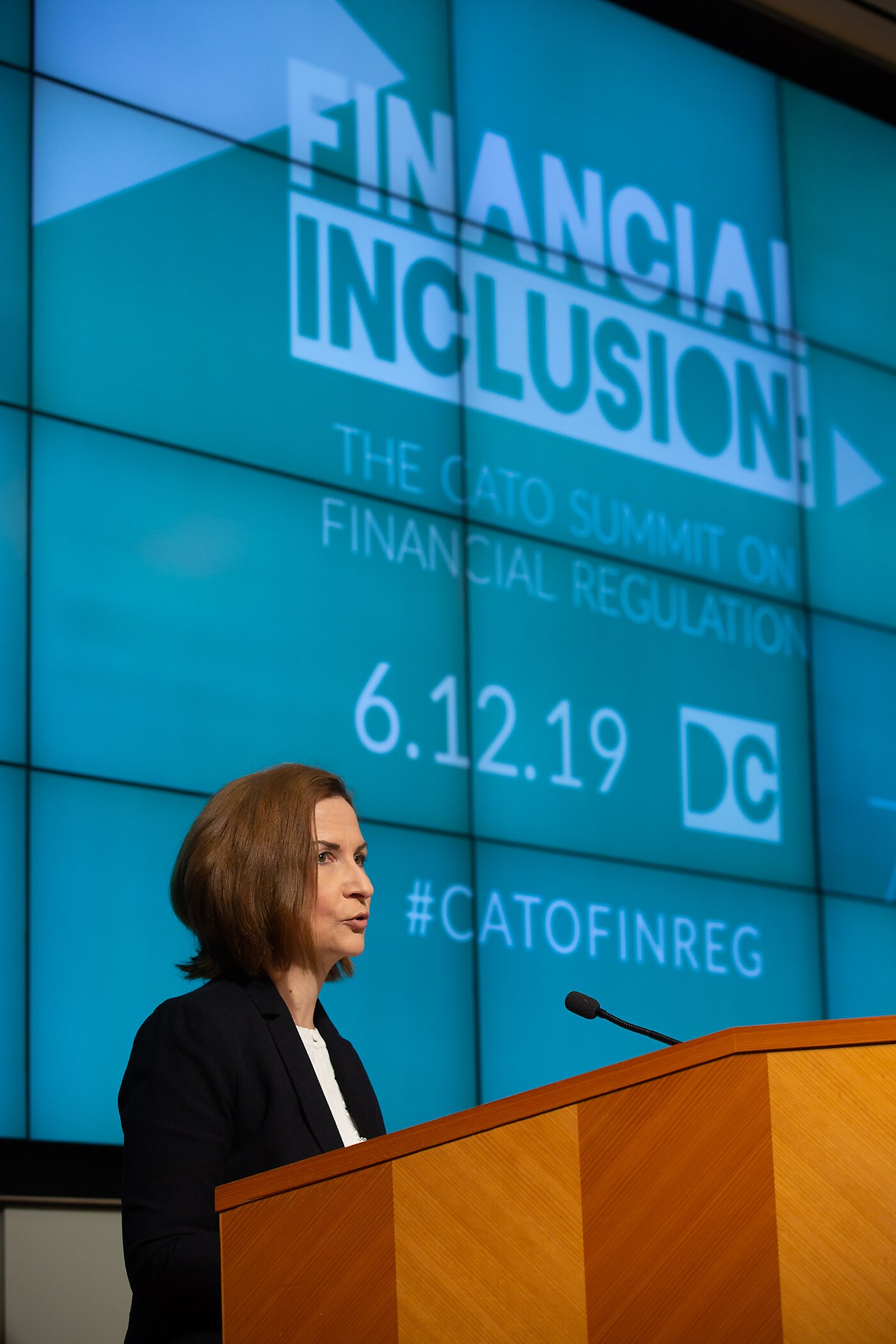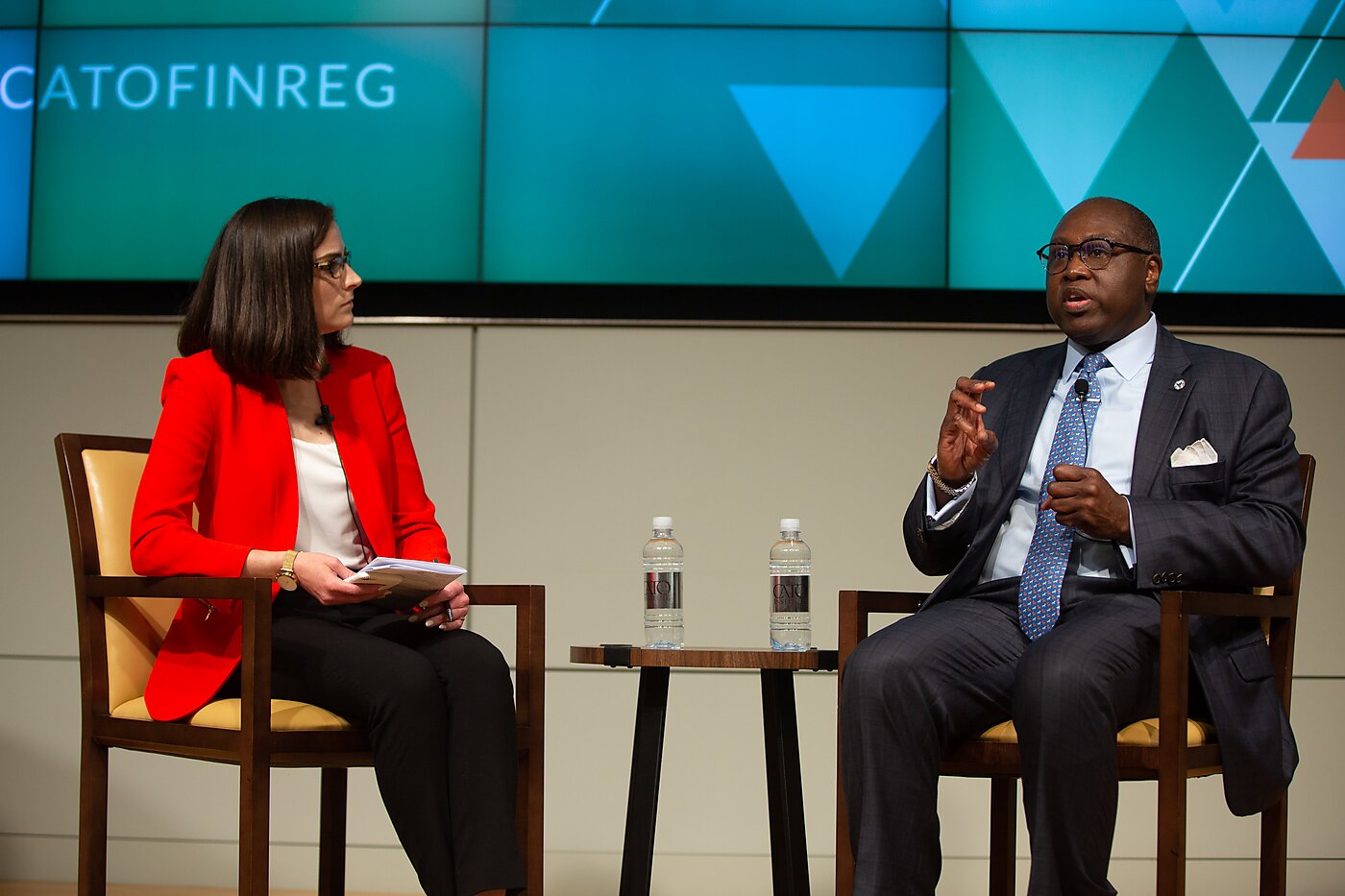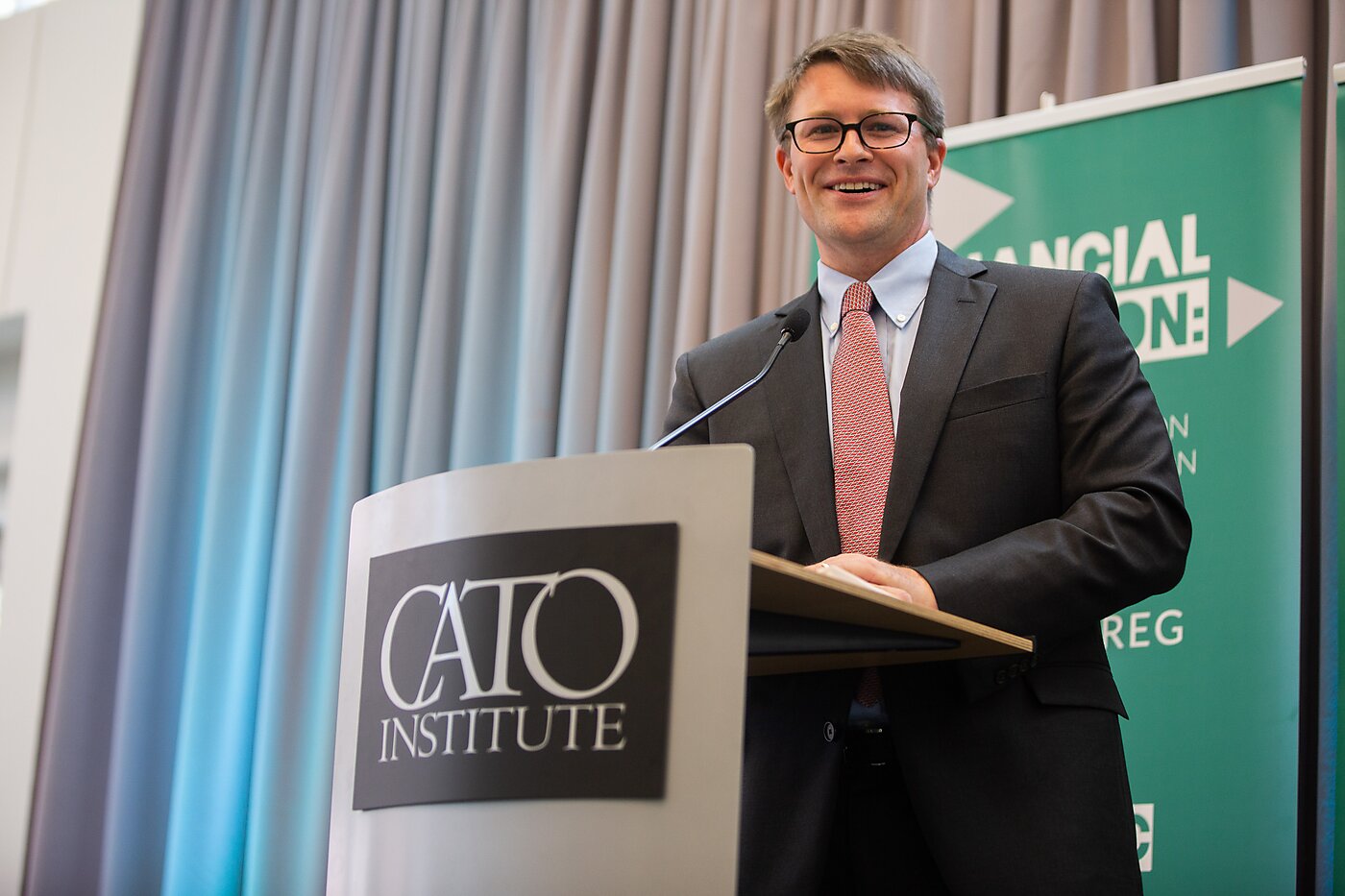New financial tools are bringing more people into the modern financial world—changing how households save, borrow, pay for everyday needs, and invest in their futures. They’re also creating new opportunities for unbanked and underbanked Americans—and new ways to serve them.
At Cato’s 5th Annual Summit on Financial Regulation, participants asked: what innovations are making access to financial services easier, safer, and more affordable? How are regulators adapting to such rapid change—and in what new ways can regulators and free markets work together to provide greater opportunities for more people to achieve economic prosperity?
Below is a summary of the event, with links to videos of each segment—the full line up and podcast versions can be found here.
Keynote Address: Jelena McWilliams, Chairman, Federal Deposit Insurance Corporation
An immigrant from the socialist republic of Yugoslavia, Jelena McWilliams arrived in the U.S. at 18 with no job, no local relatives, and no more than $500 to her name. In her opening address, McWilliams—now the Chairman of the FDIC—framed her powerful first-person narrative around her current policy philosophy: that the job of agencies like her own is to “make sure that a system built on entrepreneurship, free enterprise, and innovation continues to flourish.”
McWilliams’ remarks highlighted a number of ways that the FDIC, under her chairmanship, can fulfill that objective. These include exempting community banks from one-size-fits all regulations like the Volcker Rule, streamlining regulatory compliance requirements, and encouraging innovation in the banking sector, especially from startups and new lenders who can “offer new products and fill current gaps in underserved markets.” She spoke at length about the FDIC’s efforts to facilitate startup activity as well as lift regulations on small-dollar credit products. These products, she said, are vital to helping consumers at the margins of society begin to build good credit histories—which, as she knew from personal experience, can be the gateway to society, community, and a sense of belonging.
“People who belong are by their very nature not disenfranchised,” McWilliams said. “Economic inclusion leads to economic prosperity. I know, because I was on both sides of that proverbial fence.”
The grass, she added, was much greener on this one.
Panel I: How Credit is Reaching Underserved Communities
Bloomberg Law’s Lydia Beyoud led a discussion about how financial innovation and regulatory reform can improve credit access for low- and moderate-income (LMI) and underbanked Americans. LendUp’s Jotaka Eaddy discussed how alternative financial firms like her own are developing transparent, easily-accessible credit products and financial literacy tools that not simply provide underbanked Americans a pathway to credit, but a roadmap for building and capitalizing on that credit over time. Barry Wides, the Office of the Comptroller (OCC) of the Currency’s Deputy Comptroller for Community Affairs, discussed the OCC’s efforts to encourage greater competition in the banking sector, especially from fintechs like LendUp and other nontraditional firms. Among these, he highlighted the OCC’s recent decision to accept national bank charter applications from fintech firms.
Tom Brown, a partner at the firm Paul Hastings, pointed out that alternative financial service providers and their LMI customers face a severe disadvantage when it comes to financial inclusion. “We have regulatory barriers that are designed to reinforce a publicly granted monopoly,” he said, referring to the banking sector. No company, he argued, can offer a financial services product today without either being part of, or partnering with, the banking industry. He called for greater innovation and collaboration between the government, banking, and non-banking financial service sectors.
Cato Senior Fellow Todd Zywicki noted that regulators could do quite a lot to facilitate financial inclusion—namely, by not standing in the way of the businesses attempting to provide it. As an example, he pointed to Walmart’s ill-fated attempt at acquiring a banking charter, which the government had blocked at the behest of several large banks. He also discussed how the Credit Card Act, Durbin Amendment, and other Dodd-Frank regulations have made it more difficult for young and LMI Americans to obtain credit cards, qualify for mortgages, and achieve financial independence. Many have come to rely on payday and auto title loans as their last recourse to credit, he said; now lawmakers threaten to place similar restrictions on these products. “Financial inclusion is a moral imperative,” Zywicki insisted, adding that it was time to stop treating lower-income Americans as “second-class citizens [simply] because they lack the tools to successfully navigate the regulatory system.”
Spotlight: When Regulation Works Against Financial Inclusion
Cato Institute Policy Analyst Diego Zuluaga briefed the audience about his research on the Community Reinvestment Act (CRA) and how it had affected access to credit for LMI households in the DC region. When lawmakers passed the CRA in 1977, they hoped the Act would encourage bank lending in predominately LMI and minority communities. The law requires federal agencies to assign banks a “compliance score” based on how much of their lending goes to borrowers in historically underserved areas, and to take CRA compliance into account when considering bank branching or acquisition requests. Zuluaga explained why the Act might have outlived its usefulness and proposed a unique revision to the Act—one that would make use of the fact that CRA-exempt firms tend to do a better job of satisfying the Act’s intentions than CRA-subject ones.
Zuluaga presented data on the types of borrowers who actually receive the majority of CRA-eligible loans today. According to his research, most CRA-subject banks are “skimming the top” of their community borrowing pools, with 66% of CRA lending in the DC-area apparently going to those whom Zuluaga called “gentrifiers”—higher-income inhabitants living in traditionally lower-income communities. Zuluaga was quick to note that this behavior was not the product of any regulatory or corporate malfeasance. Instead, it was a natural consequence of the law as written, which requires due consideration for bank “safety and soundness” in its lending activities. “Even though the CRA is meeting the letter of the law,” Zuluaga explained, “it isn’t meeting the spirit of the law.”
Zuluaga proposed a solution that would take advantage of another observable market phenomenon: today, several CRA-exempt lenders seem to be better at providing credit to LMI borrowers than CRA-regulated banks. Zuluaga suggested transitioning to a system of “tradable CRA obligations,” in which banks struggling to meet the needs of their LMI borrowers can pay LMI-oriented lenders to fulfill a portion of their CRA obligations. Tradable obligations, Zuluaga noted, can better serve the intentions of the CRA—and the interests of LMI communities—than the CRA as currently constructed.
Fireside Chat with Rodney Hood, Chairman, National Credit Union Administration
CMFA Managing Director Lydia Mashburn sat down with the NCUA’s Rodney Hood, who shared his regulatory agenda for encouraging credit unions to serve LMI, minority, and underbanked Americans—something that, according to Hood, credit unions are uniquely capable of doing. Yet cumbersome regulations and Congressional inactivity often dampen credit unions’ ability to reach these populations, according to Hood. He pointed to two specific ways that Congress could help the credit unions provide greater financial opportunities for underserved communities: first, lift the cap that restricts credit union business lending to 12.25% of credit unions’ net worth; second, allow credit unions to explicitly “adopt” LMI areas in their charters.
In terms of what the NCUA itself could do, Hood explained that his regulatory approach was “pretty simple… regulation needs to be effective, but not excessive.” He added that “burdensome regulations can sometimes prevent institutions from fulfilling their mission and using the resources that they would like to use for lending and product development—[instead] they end up being used to comply with burdensome regulations.”Rather than increase regulations, Hood intends to enhance cybersecurity measures for consumers’ financial data, provide financial firms with incentives to design more small-dollar loan products and payday loan alternatives, and collaborate with private sector stakeholders to create products, services, and programs oriented toward LMI consumers’ needs. He also highlighted the innovative ways that credit unions are currently interacting with the fintech sector to achieve these goals—using resources ranging from remote deposit apps to a disaster recovery app, which a credit union in Houston had devised and shared with others in their network.
Spotlight: Bringing Faster Payments to People
CMFA Director George Selgin provided the audience a history lesson with his spotlight session, subtitled “A Tale of Two Payment Systems.” Selgin explored the private sector’s long-standing legacy of streamlining the two main elements of a fast payment system: payment initiation on the front end, and payment completion or fulfillment on the back end. He pointed to products and apps like Venmo, Apple Pay, and Paypal as modern examples of how private sector innovation can expedite the front end of retail payments. The private sector, he noted, is just as capable of bringing the same level of innovation to the back end—and even allowing both processes to be completed simultaneously. The only problem was keeping regulators from co-opting the competition.
Selgin used two examples to illustrate his point: the Suffolk Bank’s “clearing house system,” which established the first uniform payment system in the nation 200 years ago; and a modern-day consortium of banks working together through The Clearing House (or TCH for short) to develop their real-time payment (RTP) system that not only expedites the front and back end of the retail payment process, but unifies the two. Today, customers of TCH banks (or other banks with a TCH member acting as their agent) can use the inter-bank RTP system to initiate and redeem payments between one another on the same digital platform. The innovation holds incredible promise for consumers who lack access to traditional banking services, and even provides opportunities for alternative financial institutions and community banks to participate on the same platform as corporate banking titans. But there’s a hitch: the Fed is now mulling becoming a real-time payments provider itself, in direct competition with the RTP system. That move, Selgin cautioned, could easily be at odds with achieving faster payments sooner—and seems to overstep restrictions placed on the Fed by the Monetary Control Act of 1980.
Panel II: Uses Without Abuses of Consumer Data
The Washington Examiner’s Colin Wilhelm led the day’s final panel, whose speakers considered the merits and risks of using alternative data in providing financial services—particularly credit and financial literacy tools—to low-credit and “credit invisible” Americans. The panelists emphasized the importance of consumer security, transparency, and consent when it comes to the ways that financial institutions access and use alternative data. Steven Smith of Finicity provided examples of what these data are and how firms use them today, using as an example the UltraFICO score Finicity offers in partnership with Experian and FICO. With a consumer’s permission, the UltraFICO score uses additional information from his or her bank account—such as data on regular bill payments—to render a credit score for those with little or no formal credit data. The same information could also count towards, and hopefully improve, credit for those with sub-par credit scores.
The ABA’s Rob Morgan spoke about how the private sector should develop consistent, transparent rules and guidelines for the use of consumer information. Cato adjunct scholar Dan Quan agreed that private companies are the best barometer for gauging the most accurate and reliable types of alternative data, but added that many banks still lack the personnel and expertise necessary to use such data or protect it. This prompted a conversation about how financial firms can improve their own literacy with technologies like blockchain.
The panel also touched on machine learning, along with how, or whether, firms should use innovations like artificial intelligence when making lending decisions. On the one hand, artificial intelligence relies on highly precise, impartial algorithms that can predict credit risk with remarkable accuracy. But as Tracy Basinger of the San Francisco Federal Reserve pointed out, consumers need to understand how firms obtain their data and know what types of tools lenders use to evaluate their credit and approve or set terms for loans. As more firms begin to make financial decisions based on a greater variety of consumer information and new technology, she added, consumers need to understand how a greater range of financial transactions and behaviors affect their credit. They also need to learn how to use that knowledge to their advantage—developing a sense of good credit hygiene, so to speak.
Luncheon Address: Brian Johnson, Deputy Director, Consumer Financial Protection Bureau
Closing the conference was Deputy Director of the Consumer Financial Protection Bureau Brian Johnson, who explored the relationship between financial inclusion, consumer protection, and free-market innovation. Johnson defined financial inclusion as “the availability and equality of opportunity to access financial services,” as well as the absence of impediments to consumer choice—whether these impediments come from fraudulent businesses or from restrictive regulations.Johnson identified three types of consumer protection regulations: transparency and disclosure regulations; consumer welfare regulations (which prevent businesses from misleading or excluding consumers); and regulatory restrictions on product development and access. The first two types, in Johnson’s view, are market-enhancing. On the other hand, regulations that block consumers’ abilities to access products or business’ abilities to design them are not market-enhancing but “market replacing.” Johnson referred to this restrictive approach as “a regulatory policy of conscious financial exclusion.”
Johnson emphasized that, “[i]n exercising its authority, the CFPB should, first and foremost, be guided by the principle of promoting consumer choice.” He closed by echoing what seemed to be the consensus of the day: that “the free market is the greatest engine for economic mobility and financial inclusion.”





